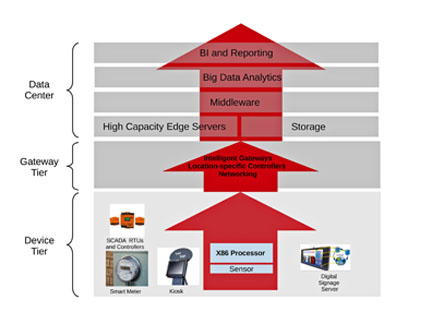Unlike the server room and the cloud, embedded computing has a clear winner when it comes to operating systems: Linux. Why is that? In a word: flexibility, and with it, Linux offers the one thing that is vital to the embedded device boom. As the enterprise and industrial worlds become more and more interested in smart devices, the need for a single, integrated, embedded operating system is key, especially one that can run a simple sensor just as effectively as the smartest “mini-server.”
Driving the embedded device boom is the concept of the “Internet of Things,” and its impact is being felt beyond just the sheer numbers of devices involved. The fact that the devices are connected has radically increased the work that they are expected to perform. The scale of industrial and consumer deployments has introduced new classes of devices such as intelligent gateways, data aggregators, and sophisticated controllers. Even the line between data center servers and devices is blurring as more traditional server functionality is being driven towards the edge where we see increased use of data appliances.
All of this means that, thanks to the IoT, a device will more likely now sit in a web of complex computing tasks that comes with new classes of requirements. Engineers can no longer afford to follow the path of developing their own operating systems. This is driving the need for flexibility and sets the stage for Linux’s domination of embedded devices. Linux can serve the small-footprint device as well a mainframe sitting in the data center and everything in between (see Fig. 1 ).

Fig. 1: Three tiers of the Internet of Things.
Figure 1 divides an IoT solution into three tiers: edge, gateway, and data center. Embedded systems operate at each architectural tier – the functionality they deliver can vary by implementation. One of the newer design principles to emerge in the IoT, especially in industrial or enterprise use cases, is expanding the role of the gateway tier. Systems in the gateway tier are now called upon to manage connectivity, including consolidating various protocols and routing packets, as well as handling data transport, typically using a messaging service for delivery assurance. Ever more frequently, these devices also perform security measures such as authentication and encryption. In widely distributed solutions, gateway tier systems will aggregate data and issue commands to devices using a lightweight business-rules engine.
Embedded Linux’s popularity is because it delivered a reliable, configurable platform that accommodated the low-energy and speed requirements of traditional embedded devices. Power, speed, footprint, and reliability are just as important as ever, especially as smart devices are being deployed in more types of locations than ever before. For example, how hot do you want a device to run that’s in a refrigerated facility or implanted in a human body? Low power is often critical. Linux has a track record of meeting essential device requirements by virtue of the following:
- Bringing the same level of stability and availability common in the data center to the field-located device
- Enabling a high level of performance on even low-cost chip architectures
- Managing power to make the most of limited battery power
- Providing utilities that provide a small footprint OS that includes only what an application requires
- Having the ability to include a high-efficiency hypervisor for economical implementation of virtualization
New classes of devices add to the list of requirements for an embedded OS, which are all robustly addressed by Linux:
- High-efficiency networking that can deliver performance in both wired and wireless deployments and handle a range of protocols
- Security for preventing unauthorized access to data
- Real-time predictability so that complex operations can be reliably driven by devices and controllers
Beyond the technical attributes embedded Linux brings to the IoT, one very obvious aspect of Linux is also critical to the future of smart devices: openness of code. As the basis for all open source operating systems, embedded and otherwise, Linux delivers transparency that traditional, proprietary technologies simply cannot. Through this transparency, flexibility is gained by having the full source code of a given operating system at hand. If a specific embedded use case is not covered by a proprietary operating system, modifications are likely to be expensive, time-consuming and overwhelmingly difficult. With the full source code in hand, customizing an embedded Linux distribution to meet specific needs is a far simpler task, as there are no closed doors or “off-limit” capabilities or functionality when it comes to modification.
This flexibility, combined with consistency of behavior across devices, architectural tiers, and physical, virtual, and cloud deployment environments, is something that Linux is best positioned to deliver to the embedded space and the Internet of Things.
Advertisement
Learn more about Red Hat





